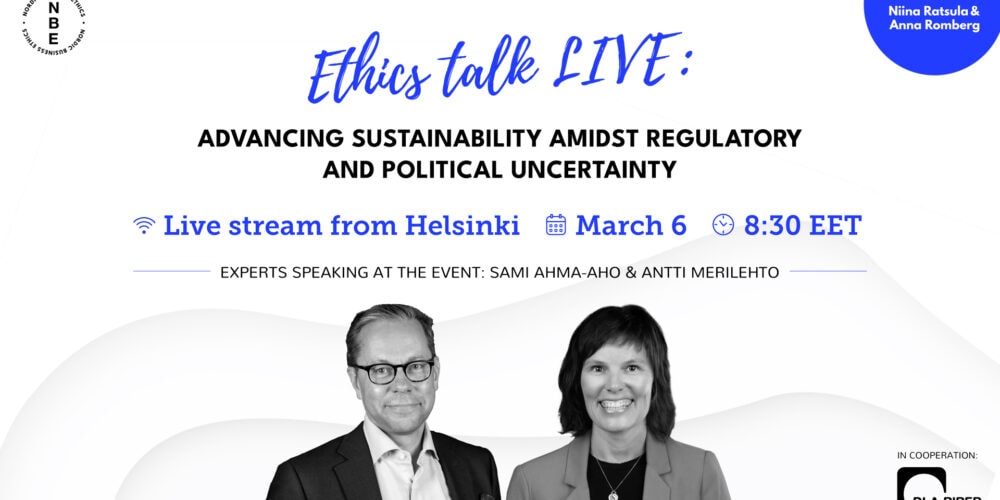Ethics Talk LIVE on corruption
As a part of the Nordic Business Ethics Survey 2022 data gathering we asked the respondents to answer a few corruption specific questions. The results are now available in the “2022 Focus on corruption” report.
With the help of the report, we discussed corruption with Sara Koski and Sam Eastwood. Sara is a Counsel in DLA Piper’s Compliance, Internal Investigations and White-Collar Defense practice in Paris and Sam is a partner in Mayer Brown’s Litigation practice in London and a member of the Firm’s White Collar Defense & Compliance practice. More details about Sara and Sam on our event page.
Know your risks!
The NBE study shows that 39% of Nordic Business Ethics Survey respondents had observed giving, asking for or receiving bribes. Sara began by commenting that it is interesting to see this type of results as the trend is upward compared to the previous results. The future will tell us if there are patterns to be noticed and whether this is a sign of increased awareness level or actual increased levels of corruption. To give a little bit more perspective to the results, Sam mentioned that “this is not a Nordic problem, it is a reflection of a bigger issue”. Sara also pointed out that the scandals that keep on happening are wake-up calls for the companies, and prove that these results are real, rather than just theoretical.
When discussing the results of the survey on what constitutes as a bribe, Sam reminds everyone that “it is entirely legitimate to have gifts even in business environment.” However, Sara brings out the problem with gifting: there is a lot of grey area, which makes it difficult for companies.
The legislation states “ do not bribe”, but does not give guidance on what is a bribe requiring strong controls and prudent approach to be deployed.
In practice, this may lead, regarding specific beneficiaries, such as public officials, to excluding gifts and invitations to leisure activities altogether.
Based on the NBE report, 58% of the 18-19 years old observe bribery, whereas the percentage is only 18% for 50+ respondents. Sara has not come across with similar results elsewhere, as age is typically not a factor in corruption studies. She believes that the results may reflect younger generations generally being more aware of this type of issues than the older generations. She also played around with the idea, that younger generations may also notice more frequently situations involving “smaller” unethical conduct or “petty corruption” whereas replies from the senior management may be more focused on bigger corporate scandals. Ethical blindness may also be a factor, as Sam mentions that “the older you get, the more conditioned by reality you become“.
Do Nordic companies struggle to recognize corruption risk?
Nordic companies have ended up in big scandals. The rootcause is not likely the lack of policies and public statements of zero tolerance. In her profession Sara has conducted several corruption risk assessments for global companies and noticed that it is very hard in practice to recognise corruption risks in one’s own operations. When the risks are assessed, in Sara’s experience, the probability level of the risks to occur is also often seen very low, which could imply underestimation in certain cases. Sara also brings out that it is important to understand that risk management is not one size fits all-type of a solution. As an example she mentions that risk management must take into account the country specifics. Understanding of the local risk universe is a key to having effective risk management practices. Recognising the red flags (and not thinking it’s a parade) is ultimately important, as what is a red flag in Finland may not play out exactly in the same way in Brazil and vice versa. Thus, a holistic view of the operating environment is needed.
Sara also ponders, if Nordic companies stumble upon their strengths: integrity and trust.
Companies may place too much trust on individuals and too little on rules and controls. Detecting corruption is very hard, even when the compliance program is mature. The enforcement activity is generally speaking also low in the Nordics, which does not actively surface the risks. Sam complemented Sara’s ideas by saying that a benign culture at home may cause problems abroad. Like Sara, he also mentioned that lack of enforcement plays a role. Sara also reminds that the CPI may give us a “wrong calmness” that does not correlate with the reality, as it is based on perception and does not include for example foreign bribery. Nordic companies just may not be prepared enough when they go abroad as the index may influence the perception of the risks.
Does the organizational structure matter?
In Sara’s experience senior management’s experience and role is incremental. The tone from the top is a real thing! Sara believes, that everyone who has gone through a corruption case, is less likely to downplay the risk, as one without the experience might not have the same acuity. In regard to centralized vs. uncentralized organizational structure neither model is either good or bad, or better or worse. There are pros and cons to both as in centralized model the management may be too far away to get the relevant information and in decentralized model the information may scatter on the way and never reach the right people. Sara reminds, that it is a key to have an escalation process and for the risk management to be infiltrated throughout the organisation. Rules and controls are important as we cannot blindly trust that we all share the same values and play by the same rules. However, we should remember that even the best programs can fail, as people do not follow the given rules and procedures. Behaviour is intabgible and very hard to control.
Is enforcement the solution?
Sara would like to see similar evolvement in Finland than what happened in France, where a similar situation existed previously. There was good legislation but very little enforcement action and corruption was not always seen as a strategic matter. The situation progressed in France through, notably, a few key points:
- Certain bigger companies and groups of companies were required to create broad compliance programmes that were based on vast risk assessments.
- National authority was set to monitor and audit these programs.
- An out-of-court settlement for criminal charges were created. This is a French equivalent of DPA (deferred prosecution agreement).
- National Presecution Authority (PNF) to handle complex financial crimes, such a complex bribery cases exists.
This has sped up the process a lot and as a result, changed the situation very fast. Additionally, through these steps compliance is now seen as a strategic asset to management.
Sam and Sara both recognize the importance of the regulatory development. Sam analyzed in regard to the whistleblowing directive that “small dripping taps are the ones that companies should try to notice and control. This way big floods will not appear”. For Sara, openness, speak-up culture and the tone from the top are incremental for the protection of the whisleblowers and will determine whether the directive will actually bring about the change it aims for.
If you are interested in watching the webinar recording, please head over to Nordic Business Ethics’ YouTube channel.



